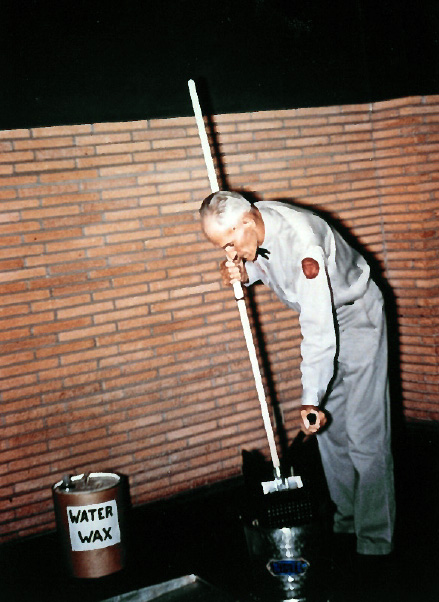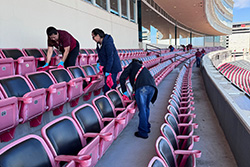History of a Janitor
The word “janitor” has its roots in Roman Mythology. Janus was the Roman god of doors, gates and portals. Janitors were once a revered occupation, known to be the “keeper of the keys.”
Early pictures of the cleaning crew at Texas Tech University give us a glimpse of what

this trade initially looked like- it was predominately
male employees whose focus was on basic tasks to keep the university looking its best. In the early years of our history, cleaning our campus was easier- fewer buildings and fewer students meant less spaces to keep clean.
As our campus has grown both in area and number of students and employees, the custodial staff has also had to adapt and grow to keep up. In response to this need, Texas Tech Custodial Services implemented the (OS1) cleaning method. This is a comprehensive cleaning system that simplifies cleaning by introducing in-depth training, standardization and the concept of team cleaning which helps employees have a more balanced workload.
(OS1) The Future of Custodial Service
James Peel, associate managing director over Custodial Services, said that the (OS1) cleaning model on campus is working to change the perception of what custodial work is; that this is a legitimate trade and that the employee must have knowledge about chemicals and the cleaning process.
“It is almost an art the way they do it [clean]” Peel said.
To be a certified custodian under the (OS1) model, employees must complete a day and a half orientation that goes over chemicals, equipment use and processes for proper and safe cleaning on campus. For example, employees learn about the standardized color-coded cleaning process the type of space is being cleaned will dictate which color mop, rag and cleaning product is used.
Charles Leatherwood, senior managing director with the Operations Division praised the custodial staff 's efforts with (OS1) and stated that the department continues to benefit from the ongoing training provided by the program.
“They exemplify professionalism, knowledge of their skill, organization and standardized procedures which helps keep our campus healthy and clean” Leatherwood said.
The team has also implemented an equipment check-in and check-out process for all cleaning machines. This has ensured that broken parts and equipment are replaced as soon as possible so the staff can be successful in their job responsibilities.
(OS1) Cleaning Approach
One way the (OS1) cleaning approach is different from other programs is through their
philosophy of cleaning. The (OS1) cleaning philosophy goes beyond mops and cleaning
supplies to the holistic view of the employee. One of the bedrocks of the program
is “Treat Cleaning Workers as First Class Citizens.” Texas Tech works to achieve this
by creating a professional workspace for the custodial staff. This shows that we value
them and their important work on our campus; that we do not underestimate how hard
they
work everyday.
Another core philosophy of (OS1) is “Clean for Health First, Then Appearance.” This is a departure from the original days of Texas Tech where appearance would have been the most important factor of cleaning. But now, with the emergence of the COVID-19 pandemic, health is the forefront goal of our custodial staff.
It was the implementation of (OS1) that helped the custodial staff during the early days of the pandemic as they already had built up a bulk storage of cleaning supplies that would have been otherwise hard to obtain during the supply chain shortages.
Clean Syndrome
Another guidepost of the (OS1) cleaning process is known as “Clean Syndrome.” The (OS1) class explains this as, “things that are clean tend to stay clean because people get the psychological cues to keep it that way.” If you walk into a clean room, you tend to pick up after yourself because of the desire to maintain the clean appearance. If a space looks like nobody cares about it, then no one will appreciate it; but the stewardship and dedication of our custodial staff ensures a clean environment for all of us.
(OS1)'s Goal
The (OS1) cleaning system is about 50% rolled out across campus and there are plans for its continued growth. In FY23 two new buildings were converted over to this cleaning model - Admin Support, including the University Police Department and Media and Communications. The goal is to have all buildings on campus converted to this (OS1) cleaning system by 2025.
Custodial Staff
The custodial team have staff on shift seven days a week, 24 hours a day. They even

cover holidays as not all offices close, such as the Police Department. They work tirelessly after most major events on campus. During football season, for example, they work to clean all interior spaces and suite balconies before, during and after the season ends. They also have worked to change the hours they are visible on campus. In the past, they would only come in to clean after hours when offices were closed. Now, they work when people are around, so they are more recognizable to the building staff.
“When people know their custodian it makes things better” Peel added.
Changing their working shifts has also helped with the completion of work orders. Now when the custodial staff receive work orders during the day, they have staff on hand who can complete them quickly. The custodial staff is thankful to have support for the (OS1) program from leadership across campus, as it creates a healthy and safe environment.
Sean Childers, associate vice president over the Operations Division, appreciates that the program places more focus on the employee rather than the task. He believes this creates “a more conducive and supportive work environment not only enhancing the experience of the team member, but the facilities we are privileged to maintain.”
